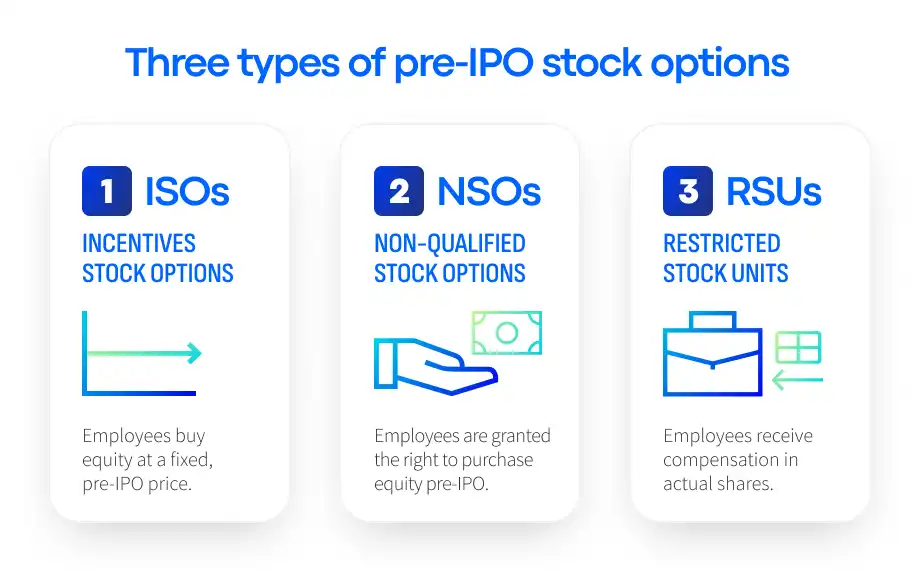By Sunita Arnold, Nov 2, 2023

Table of Contents
Imagine unlocking significant wealth potential by strategically managing pre-IPO stock options. Pre-IPO stock options can offer valuable wealth-building opportunities if managed strategically. This guide will explain key concepts for employees or investors new to stock options, from understanding different types to exercising them optimally. With the right knowledge and approach, you can make informed decisions that could transform your financial future. In this comprehensive guide, we’ll explore the world of pre-IPO stock options, from understanding their types and tax implications to evaluating company potential and navigating lockup periods. Let’s dive in and uncover the secrets to maximizing the value of your pre-IPO stock options.
Pre-IPO stock options are financial instruments that grant employees the right to buy a company’s equity at a set price before it goes public. These options are typically offered to early employees, venture capital firms, and individuals with an association to the company. While private companies can formulate their own criteria for pre-IPO stock option allocations, equity awards and stock options are the primary components of pre-IPO companies’ compensation programs.
A tailored allocation system based on a company’s circumstances, valuations, objectives, and other considerations is usually employed for pre-IPO stock options. Companies often utilize the percentage ownership approach for allocating pre-IPO stock options, with the strike price or exercise price being the predetermined price at which the stock options can be purchased prior to vesting. An employee can exercise pre-IPO stock options by purchasing the allocated shares at the contract-specified exercise price, assuming the shares have vested following the vesting schedule.
The exercise period is the time frame in which an employee can exercise their stock options to obtain actual shares. A liquidity event, such as an IPO, merger, or acquisition, may provide an opportunity for employees to sell their shares and realize the value of their pre-IPO stock options.
Before you decide to exercise your options, consider the following:
Grant employees the right to purchase a company’s equity at a predetermined price prior to its initial public offering. Issuing ISOs to a private business during its early stages and when its valuation is low can be highly advantageous. Companies typically include restrictions on ISOs in the option contract to ensure that the ISOs are aligned with the organization’s long-term goals and objectives. ISOs are generally granted to employees who fulfill specific criteria.
Also grant employees the right to purchase a company’s equity at a predetermined price before it goes public. NSOs are typically extended to individuals outside the organization and employees who may not meet the stringent conditions usually associated with ISO contracts. The exercise price can be determined at a value lower than the fair market value (FMV) of the stock on the grant date. With stock option grants like NSOs, income tax is incurred when exercised, based on the difference between the stock’s fair market value and the exercise price.
RSUs are pre-IPO stock options provided as employee compensation, representing actual company shares, not a distinct allotment of shares requiring individual purchase. The value of RSUs at the time of vesting is generally based on the fair market value (FMV) of the company’s stock. This amount is usually the same as that of an employee’s purchase price for the same stock units. RSUs are typically subject to a vesting period. During this time, employees cannot access their shares until the vesting has been completed.
These three types of pre-IPO stock options have differing tax implications. ISOs may be eligible for advantageous tax treatment when certain criteria are satisfied, whereas NSOs are subject to ordinary income tax upon exercise, dependent on the disparity between the exercise price and the FMV of the stock on the exercise date.

Vesting refers to the process through which held ISOs, NQSOs, or RSUs become available to the holder. A vesting schedule in pre-IPO is a timeline that outlines the conditions for option holders to exercise their options or to claim ownership rights of pre-IPO stocks. In particular, this applies to RSUs (Restricted Stock Units).
In most industries, there are three common types of vesting schedules for stock options:
Grasping the vesting and exercise periods is key to identifying the best time to exercise pre-IPO stock options for maximizing their potential value. It’s important to be aware of any liquidity events, such as IPOs, mergers, or acquisitions, which may provide an opportunity to sell the shares and realize the value of the pre-IPO stock options.
Step into the high-reward world of private equities. Don’t wait, your portfolio expansion starts here!

The tax implications of pre-IPO stock options can significantly impact your decision to exercise them. As mentioned earlier, ISOs may be eligible for advantageous tax treatment when certain criteria are satisfied, whereas NSOs are subject to ordinary income tax upon exercise. Exercising pre-IPO stock options before the IPO and holding the shares for at least 12 months can allow for the application of long-term capital gains tax rates, which are more favorable than the tax rates that would be applicable after the IPO.
Additionally, if an employee exercises ISOs and the IPO fails or does not meet expectations, they may be able to recoup some of the loss via an AMT credit, which serves as a tax credit that can be utilized in subsequent years. The effective tax rate may vary depending on individual circumstances, including:
The early exercise and the 83(b) election provide an opportunity for an employee to:
A qualifying disposition is subject to more favorable long-term capital gains rates, and if you exercise pre-IPO, the holding period of your stock option begins on the date of exercise, indicating that you may satisfy the qualifying disposition holding requirement by the time the post-IPO lockup period ends. This can result in tax savings and potentially higher gains on your pre-IPO stock options.
Prior to exercising pre-IPO stock options, assessing the company’s potential is necessary. This includes analyzing the company’s financials, competitive environment, and long-term capital gains advantages. Analyzing income statements, cash flow (showing cash generated/spent), and balance sheets (assets/liabilities) can provide insights into revenue growth, profitability, cash generation, and capital structure. Assess key ratios like revenue growth rate, gross margin, operating margin, and current ratio. Research the company’s competitors, their market share, product differences, and competitive advantages to evaluate the company’s positioning.
Market research is another valuable tool for assessing a pre-IPO company’s potential. Gathering information about customers and target markets can help determine if a business has a viable product or service and advantageous market positioning. The S-1 form, submitted to the Securities and Exchange Commission (SEC) by companies intending to go public, offers a comprehensive overview of a company’s risk factors, growth strategies, and operations.
Taking the time to carefully evaluate the potential of a pre-IPO company can help ensure that your investment in pre-IPO stock options is well-placed. This can be especially important when considering the potential tax implications and lockup periods that may impact your ability to sell your shares after the company goes public. Once you have thoroughly evaluated the company’s potential, the next step is determining the optimal strategies for exercising your pre-IPO stock options.

When contemplating whether to exercise your pre-IPO stock options, you should weigh factors like tax implications, the potential of the company, and your personal financial goals. This involves evaluating the company’s performance, assessing market conditions, and determining the potential risks and rewards associated with exercising your stock options.
Balancing these factors can help you make informed decisions about when and how to exercise your pre-IPO stock options. For example, exercising your options early and holding onto the shares for a certain period can unlock long-term capital gains tax advantages. Additionally, being aware of any liquidity events, such as IPOs, mergers, or acquisitions, can help you time the exercise of your stock options to maximize their potential value.
Your pre-IPO stock option strategy should be in line with your personal financial objectives, encompassing liquidity needs, risk tolerance, and long-term investment goals. By carefully considering these factors and evaluating the potential of the company in question, you can make more informed decisions about exercising your pre-IPO stock options. One key strategy to consider is early exercise to take advantage of long-term capital gains tax rates.
A major benefit of exercising pre-IPO stock options early is the potential eligibility for long-term capital gains tax rates. If you exercise your stock options before the IPO and hold the shares for at least 12 months, you may be eligible for more favorable long-term capital gains tax rates, which can result in tax savings and potentially higher gains on your pre-IPO stock options.
Yet, it’s necessary to understand the potential risks tied to postponing the sale of pre-IPO shares until they qualify for long-term capital gains. For example, the stock price may decline in the interim, potentially resulting in a loss on your investment. Nevertheless, the potential tax savings and increased gains from long-term capital gains tax rates can make early exercise an attractive option for some employees, who would then need to pay capital gains tax.
Leverage the power of private equities. Make your move and accelerate your wealth creation journey today!
Handling lockup periods and liquidity events can pose challenges, due to their potential to limit the sale of pre-IPO shares and affect the timing of stock option exercise. Companies impose strict restrictions on the transfer of pre-IPO stock options or shares, making it difficult for employees to sell their shares or exercise their options at the most opportune time.
Employees requiring immediate access to funds will not be able to access the capital of their pre-IPO stock until the lockup period has expired. However, pre-IPO shares may be subject to liquidity events such as:
These events can provide opportunities for employees to sell their shares and realize the value of their pre-IPO stock options.
Being aware of these challenges and understanding the restrictions on the transfer of pre-IPO stock options or shares can help you make more informed decisions about when and how to exercise your stock options. By carefully considering the potential impact of lockup periods and liquidity events on your pre-IPO stock options, you can better navigate these challenges and maximize the value of your investment.
If you’re thinking about exercising your pre-IPO stock options but are uncertain about funding the exercise costs, various options are at your disposal. Non-recourse financing and secondary market sales are two potential options for financing pre-IPO stock options exercises, allowing employees to manage the associated costs.
Private-company stock-option financing is a form of non-recourse financing that provides capital to employees to fund the exercise cost of stock options and pay associated taxes. This can be a viable option for employees who are unable to finance the exercise costs independently. However, one potential drawback of utilizing this financing option is that you would be sharing the upside with the financing company.
Another financing option is to sell your pre-IPO shares to a third party on the secondary markets. While this can provide immediate liquidity, it may also result in relinquishing your opportunity to capitalize on the profits of a successful exit, thus missing out on any additional gains. Weighing the respective prices for which you can sell your shares against the rates available for exercise financing can help you make the best decision based on your personal financial situation.
There are numerous successful pre-IPO stock option stories worldwide, but two noteworthy cases are DoorDash and Pinterest. DoorDash had a successful IPO valuing the company at $60 billion, benefiting early employees who held pre-IPO stock options and exercised them at the right time. Similarly, Pinterest’s IPO made instant millionaires out of early employees who had wisely managed their pre-IPO stock options.
These examples illustrate the potential wealth-building opportunities for employees who effectively manage their pre-IPO stock options. By thoughtfully weighing up aspects like tax implications, the potential of the company, and your personal financial goals, you can make educated decisions on when and how to exercise your pre-IPO stock options, which might unlock considerable wealth potential.
In conclusion, pre-IPO stock options offer employees and investors the potential to build wealth through the appreciation of the company’s stock price. By understanding the types of pre-IPO stock options, tax implications, company potential, and various strategies for exercising these options, you can make informed decisions that maximize the value of your pre-IPO stock options. As demonstrated by successful case studies like DoorDash and Pinterest, effectively managing pre-IPO stock options can lead to significant wealth-building opportunities.
This material, provided by Linqto, is for informational purposes only and is not intended as investment advice or any form of professional guidance. Before making any investment decision, especially in the dynamic field of private markets, it is recommended that you seek advice from professional advisors. The information contained herein does not imply endorsement of any third parties or investment opportunities mentioned. Our market views and investment insights are subject to change and may not always reflect the most current developments. No assumption should be made regarding the profitability of any securities, sectors, or markets discussed. Past performance is not indicative of future results, and investing in private markets involves unique risks, including the potential for loss. Historical and hypothetical performance figures are provided to illustrate possible market behaviors and should not be relied upon as predictions of future performance.
How do stock options work for pre-IPO companies?
Pre-IPO stock options are a form of alternative compensation used for recruitment, retention, and incentives. They are offered at a predetermined exercise price and vest over a stated period of time, allowing you to purchase company stock shares afterwards. With public company ISOs, you may also be eligible to pay only 35% in taxes instead of 51%.
How do I buy pre-IPO options?
To purchase pre-IPO options, you can use a specialized broker, purchase equity directly from the company, or invest through firms that own the stock.
Can I sell my pre-IPO stock options?
Yes, you can sell your pre-IPO stock options. A number of web-based companies, such as EquityZen and Forge, connect sellers of, and investors in, pre-IPO shares, while some plans may allow for the sale of pre-IPO shares to a third party. Additionally, secondary markets enable employees and shareholders to list and sell their private shares if someone is willing to buy them.
Can you buy pre-IPO stocks?
It is possible to access high-growth startups before an IPO and potentially realize outsized returns by buying pre-IPO shares, despite the associated risks and downsides.
What happens when a company goes public?
An IPO (Initial Public Offering) is the process through which a private company becomes publicly traded, allowing anyone to buy or sell shares in the company on a stock exchange. The company issues a certain number of shares at an offering price, and then begins trading on public exchanges.